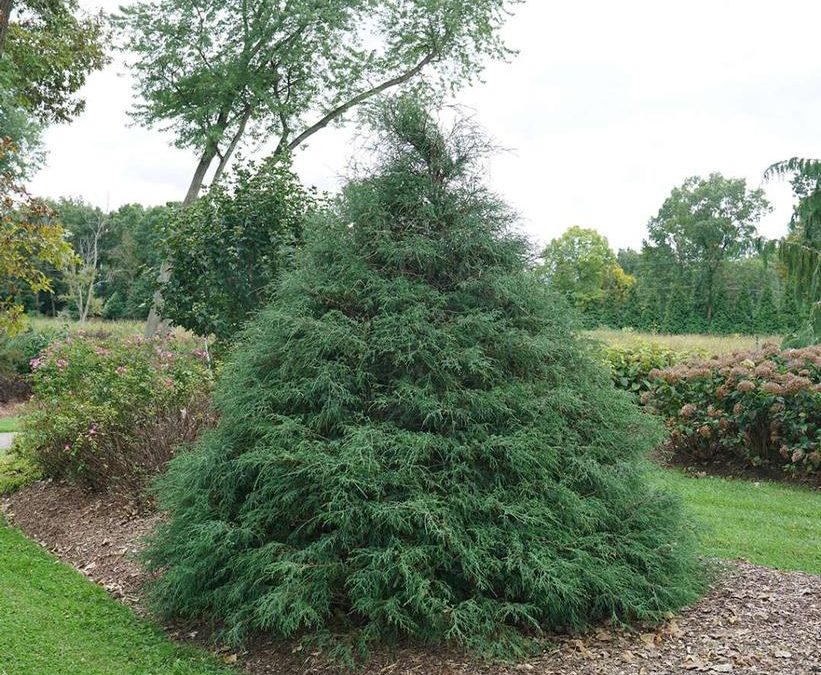
Common Name: Haywire Port Orford Cedar
Bloom Time: Evergreen (year-round interest)
USDA Zones: 5–8 (cold-hardy enough for Southeastern Wisconsin with protection in exposed sites)
Mature Size: 8–12 ft. tall × 3–5 ft. wide
Habit: Narrow, upright conifer with slightly twisted, textural foliage
Foliage: Blue-green, thread-like sprays that retain color all year
Introduction
Gardeners who want an evergreen with personality will love the Haywire Port Orford Cedar. Unlike traditional upright evergreens with stiff formality, Haywire brings a playful twist: its thread-like blue-green foliage grows in slightly irregular sprays, creating a textured, modern look. Compact in width but with strong vertical presence, it’s an excellent choice for accent plantings, narrow screens, or focal points in Southeastern Wisconsin gardens.
Heritage Hill Nursery carries the Haywire Port Orford Cedar, a unique evergreen selection:
👉 Shop Haywire Cedar
Origins & Description
The Port Orford cedar (Chamaecyparis lawsoniana) is native to the Pacific Northwest, where it grows into towering trees. Cultivated selections like ‘Haywire’ were bred for compact garden use and distinctive foliage character.
Haywire stands out for its thread-like sprays of blue-green foliage with a slightly twisted habit, giving it both elegance and whimsy. It grows at a moderate pace into a narrow, upright form about 8–12 feet tall, perfect for smaller gardens where a standard arborvitae or spruce might overwhelm.
Unlike some conifers that lose color in winter, Haywire retains a steady, muted blue-green tone year-round, making it a dependable anchor plant in all seasons.
Ideal Growing Conditions (Southeast Wisconsin Focus)
-
Light: Full sun to light shade. More sun enhances stronger color and tighter form.
-
Soil: Prefers moist, well-drained, slightly acidic soil. Avoid heavy clay that stays wet, as this can lead to root issues.
-
Moisture: Consistent moisture is important, especially in the first 2–3 years. Mulch helps retain soil moisture.
-
pH: Slightly acidic soils (5.5–6.5) are best.
-
Hardiness: Hardy to Zone 5. In exposed Wisconsin winters, wind protection (such as burlap screens) can prevent desiccation.
Planting & Establishment
When to Plant:
How to Plant:
-
Dig a hole twice as wide and equal depth as the root ball.
-
Place the plant so its crown sits level with soil.
-
Backfill with amended native soil, water deeply, and mulch with 2–3 inches of organic matter.
-
Keep mulch a few inches from the trunk to prevent rot.
Spacing: Plant 3–5 feet apart for screening; single specimens can stand alone with room to show off their character.
Care & Maintenance
-
Watering: Keep soil evenly moist, especially in hot summers. Deep weekly watering is better than frequent shallow watering.
-
Fertilizer: Feed lightly in spring with a conifer fertilizer or compost to encourage steady growth. Avoid excessive nitrogen.
-
Pruning: Minimal. Naturally tidy and narrow, but can be lightly shaped in early summer if desired. Avoid cutting into old wood, as regrowth may not occur.
-
Winter Care: In open or windy exposures, wrap young plants with burlap for the first few winters to prevent foliage burn.
-
Longevity: With proper siting and care, Haywire will provide decades of beauty and structure.
Landscape Uses & Companions
-
Vertical Accent: Perfect as a specimen tree in smaller gardens or mixed borders.
-
Privacy Screens: Narrow habit makes it useful where space is tight.
-
Modern Gardens: Its unusual texture pairs beautifully with clean architectural lines.
-
Companions: Works well with ornamental grasses, hydrangeas, viburnums, or perennials like coneflowers and sedum for year-round layering.
Seasonal Calendar (Wisconsin)
-
Spring: Plant new specimens, fertilize lightly.
-
Summer: Water consistently in dry spells. Enjoy steady, upright growth.
-
Fall: Good planting window through September; water before ground freezes.
-
Winter: Protect from harsh winds if in an exposed site.
Troubleshooting
-
Browning Tips: Usually caused by winter burn or drought stress. Water deeply in fall and use burlap wraps in windy sites.
-
Slow Growth: Normal for this cultivar; growth is moderate. Fertilize lightly in spring for a gentle boost.
-
Root Problems: Avoid waterlogged soils; amend with compost to improve drainage.
Ecological & Garden Value
-
Year-Round Beauty: Provides evergreen presence in the garden through all seasons.
-
Wildlife Habitat: Offers shelter for small birds and beneficial insects.
-
Low Maintenance: Naturally compact habit means little to no pruning.
-
Unique Character: Adds texture and personality to foundation plantings or mixed borders.
Ready to Plant?
For gardeners seeking an evergreen that’s both structural and whimsical, the Haywire Port Orford Cedar is a unique, hardy option. With its narrow form and textural blue-green foliage, it’s an elegant solution for small spaces or striking vertical accents.
👉 Shop Haywire Cedar
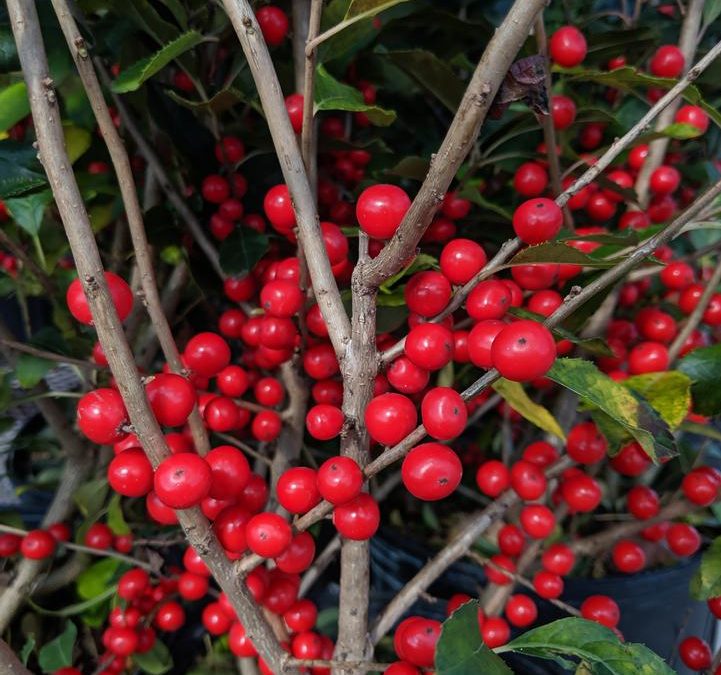
Common Name: Red Sprite Winterberry
Bloom Time: Inconspicuous white flowers in late spring to early summer (May–June)
Fruit Time: Bright red berries from fall through winter
USDA Zones: 3–9 (hardy in Southeastern Wisconsin)
Mature Size: 3–5 ft. tall × 3–5 ft. wide
Habit: Compact, rounded deciduous holly
Foliage: Glossy green leaves turning yellow in fall; bare stems in winter highlight berries
Introduction
When the garden landscape turns gray and bare in late fall, Red Sprite Winterberry delivers an unforgettable splash of festive color. This compact shrub is a female cultivar of the native winterberry holly (Ilex verticillata), producing brilliant clusters of red berries that persist well into winter and often through early spring.
For Wisconsin gardeners, this means months of vibrant display against snow and evergreens, along with a critical food source for birds when other food is scarce. Its compact size makes it suitable for small gardens, foundation beds, or grouped plantings for mass berry impact.
Heritage Hill Nursery offers Ilex verticillata ‘Red Sprite’, a top-performing selection for our region:
👉 Shop Red Sprite Winterberry
Origins & Description
Winterberry holly is native to eastern North America, thriving in wetlands, woodland edges, and moist meadows. Unlike evergreen hollies, this species is deciduous, dropping its leaves in autumn to reveal heavy clusters of red fruit on bare stems.
The ‘Red Sprite’ cultivar is one of the most compact and berry-laden selections available. Its fruit is larger than most winterberry varieties, and because of its smaller stature, the berries are displayed prominently, creating an eye-catching winter feature.
As with all hollies, Red Sprite is dioecious, meaning it requires a male pollinator nearby for berry production. The male cultivar ‘Jim Dandy’ is the best pollinator for Red Sprite, flowering at the same time.
Ideal Growing Conditions (Southeast Wisconsin Focus)
-
Light: Full sun to part shade. More sun means heavier fruit set.
-
Soil: Prefers moist, acidic soils rich in organic matter. Tolerates clay soils if drainage is adequate.
-
Moisture: Excellent choice for rain gardens, low spots, or near water features. Requires consistent moisture to thrive.
-
pH: Slightly acidic soils (5.0–6.5) are best; avoid alkaline soils which can cause chlorosis.
-
Hardiness: Extremely cold-hardy, thriving in Wisconsin’s harsh winters.
Planting & Establishment
When to Plant:
How to Plant:
-
Dig a hole twice as wide and the same depth as the container.
-
Place the plant level with surrounding soil.
-
Backfill with soil mixed with compost for fertility.
-
Water deeply and apply a 2–3 inch mulch layer, keeping mulch away from the crown.
Pollination Needs:
For berries to form, plant a male pollinator (‘Jim Dandy’) within 50 feet of female shrubs. One male can pollinate multiple females.
Care & Maintenance
-
Watering: Keep soil evenly moist, especially during dry spells. Red Sprite does not tolerate prolonged drought.
-
Fertilization: Apply an acid-loving plant fertilizer (similar to azalea or rhododendron food) in spring.
-
Pruning: Minimal. If needed, prune in late winter before spring growth. Avoid heavy pruning as it may reduce berry set.
-
Pests & Disease: Generally pest-free and not favored by deer, making it an excellent low-maintenance choice.
-
Winter Care: No special protection needed. Berries naturally persist through snow and ice.
Propagation
Winterberry can be propagated by softwood cuttings in summer or by division of suckers. However, for reliable performance, it’s best to purchase named cultivars like Red Sprite and its pollinator Jim Dandy.
Landscape Uses & Companions
-
Winter Interest: Outstanding berry display provides seasonal cheer and curb appeal.
-
Wildlife Gardens: A valuable food source for winter birds such as cedar waxwings and robins.
-
Rain Gardens: Thrives in damp, low-lying areas.
-
Foundation Plantings: Compact form works well near walkways or porches.
-
Companions: Pair with other moisture-loving shrubs like summersweet (Clethra alnifolia), viburnums, or ornamental grasses for layered interest.
Seasonal Calendar (Wisconsin)
-
May–June: Small white flowers bloom; pollination occurs.
-
July–August: Fruit begins to swell and color.
-
September–October: Leaves turn yellow and drop, revealing ripened berries.
-
Winter: Bright red berries persist for months, glowing against snow.
Troubleshooting
-
No Berries: Usually due to lack of a male pollinator or mismatched bloom times. Be sure to plant ‘Jim Dandy’.
-
Yellow Leaves: May indicate alkaline soil. Test soil and amend with sulfur or peat to increase acidity.
-
Sparse Growth: Often caused by drought stress. Maintain consistent moisture.
Ecological & Garden Value
-
Pollinator Support: Flowers provide nectar and pollen for bees in late spring.
-
Bird Value: Berries feed songbirds throughout the winter.
-
Native Heritage: As a North American native, it thrives naturally in Wisconsin’s climate.
-
Seasonal Highlight: One of the few shrubs that shines brightest in the dead of winter.
Ready to Plant?
Add a burst of holiday-red color to your winter garden with Red Sprite Winterberry. Compact, low-maintenance, and wildlife-friendly, it’s a perfect addition to Wisconsin landscapes.
👉 Shop Red Sprite Winterberry
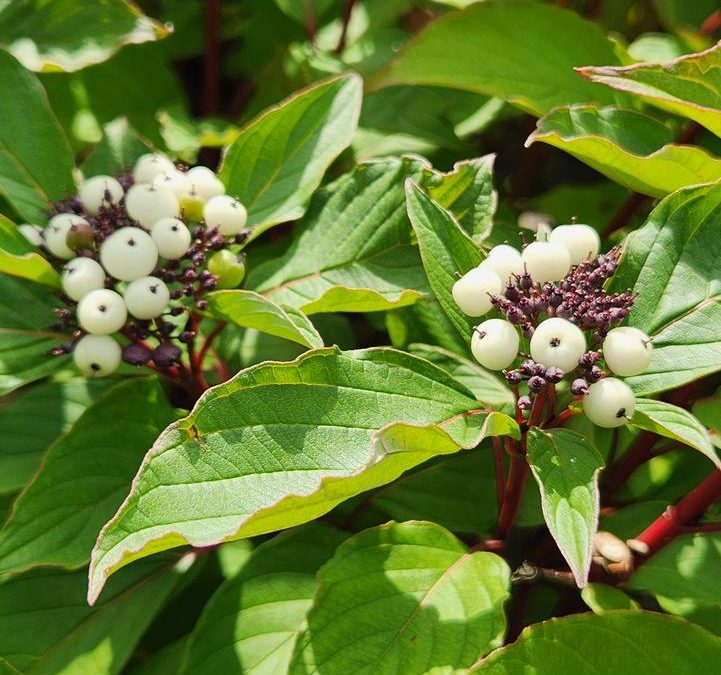
Common Name: Red Osier Dogwood ‘Baileyi’
Bloom Time: Late spring to early summer (May–June), with ornamental fruit in late summer
USDA Zones: 2–7 (exceptionally hardy in Southeastern Wisconsin)
Mature Size: 8–10 ft. tall × 8–10 ft. wide
Habit: Multi-stemmed, rounded shrub
Foliage: Green leaves turning red-purple in fall
Winter Interest: Striking red stems visible after leaf drop
Introduction
Few shrubs provide as much four-season beauty as the Red Osier Dogwood ‘Baileyi’. With its clusters of creamy white spring flowers, lush summer foliage, attractive white berries, and fiery red stems in winter, this native shrub is a true all-year performer in Southeastern Wisconsin landscapes. Its adaptability to a wide range of soils—including wet or poorly drained sites—makes it both functional and ornamental.
Heritage Hill Nursery carries the Baileyi Red Osier Dogwood—a reliable, hardy choice for local gardens:
👉 Shop Cornus sericea ‘Baileyi’
Origins & Description
The Red Osier Dogwood (Cornus sericea), sometimes called red-twig dogwood, is native across much of North America. The ‘Baileyi’ cultivar is a particularly vigorous selection prized for its bright red stems that intensify in winter.
In spring, the shrub produces flat-topped clusters of creamy white flowers that attract pollinators. These are followed by clusters of bluish-white berries in summer, which are loved by birds. Fall brings a bold display of reddish-purple foliage, and when the leaves drop, the brilliant red stems take center stage, glowing against snow or evergreens.
The shrub forms a full, rounded shape and naturally suckers, creating dense thickets if allowed—perfect for erosion control or wildlife plantings.
Ideal Growing Conditions (Southeast Wisconsin Focus)
-
Light: Full sun to part shade. Best stem color develops in full sun.
-
Soil: Very adaptable. Prefers moist, well-drained soils but tolerates clay and even wet soils.
-
Moisture: Excellent choice for rain gardens, streambanks, and low spots. Handles seasonal flooding better than most shrubs.
-
pH: Neutral to slightly acidic soils are preferred.
-
Hardiness: Thrives in cold climates, reliably hardy in Zone 2–7.
Planting & Establishment
When to Plant:
How to Plant:
-
Dig a hole twice the width of the root ball and the same depth.
-
Place shrub so crown sits level with surrounding soil.
-
Backfill with native soil and water deeply.
-
Mulch 2–3 inches around the base to conserve moisture and suppress weeds.
Spacing: For hedges or screens, plant 6–10 feet apart. For naturalized groupings, allow more room to spread.
Care & Maintenance
-
Watering: Keep evenly moist, especially in the first two years. Once established, it is tolerant of a wide range of conditions.
-
Pruning: To maintain vibrant red stems, remove 1/3 of the oldest stems each spring. New growth has the brightest color.
-
Fertilization: Apply compost or a balanced shrub fertilizer in early spring if soil is poor.
-
Pests & Disease: Generally trouble-free. Leaf spots may occur in wet summers but rarely threaten plant health.
-
Winter Care: None needed; stem color improves in cold weather.
Propagation
Red Osier Dogwood naturally suckers, making it easy to propagate by digging up and replanting young shoots. It can also be propagated by hardwood cuttings taken in winter.
Landscape Uses & Companions
-
Winter Interest: Bright red stems create a stunning winter display, especially against snow or evergreens.
-
Rain Gardens & Wet Sites: Thrives where many other shrubs would fail.
-
Erosion Control: Strong root systems help stabilize slopes and streambanks.
-
Wildlife Habitat: Provides food and shelter for birds and pollinators.
-
Companions: Pair with evergreens like spruce or arborvitae for winter contrast, or mix with other winter-stemmed dogwoods (yellow-twig or orange-twig) for a colorful winter display.
Seasonal Calendar (Wisconsin)
-
May–June: White flower clusters bloom, attracting pollinators.
-
July–August: White-blue berries ripen, feeding birds and wildlife.
-
September–October: Foliage turns red-purple.
-
Winter: Bare red stems provide dramatic seasonal color.
Troubleshooting
-
Sparse Stem Color: Prune out old stems regularly to encourage fresh red growth.
-
Excessive Spread: Thin or prune suckers to maintain desired shape.
-
Leaf Spots: Occasional in wet weather, but not serious.
Ecological & Garden Value
-
Pollinator Friendly: Flowers attract bees and butterflies.
-
Bird Habitat: Berries provide late-summer food, while dense branching offers nesting cover.
-
Soil & Water Benefits: Ideal for stabilizing banks, filtering runoff, and supporting wetland ecosystems.
-
Four-Season Beauty: Flowers, berries, fall foliage, and winter stems ensure year-round appeal.
Ready to Plant?
If you’re looking for a hardy, versatile shrub that shines in every season, the Red Osier Dogwood ‘Baileyi’ is a must-have. Its resilience, ecological value, and stunning winter color make it a standout for Wisconsin gardens.
👉 Shop Cornus sericea ‘Baileyi’
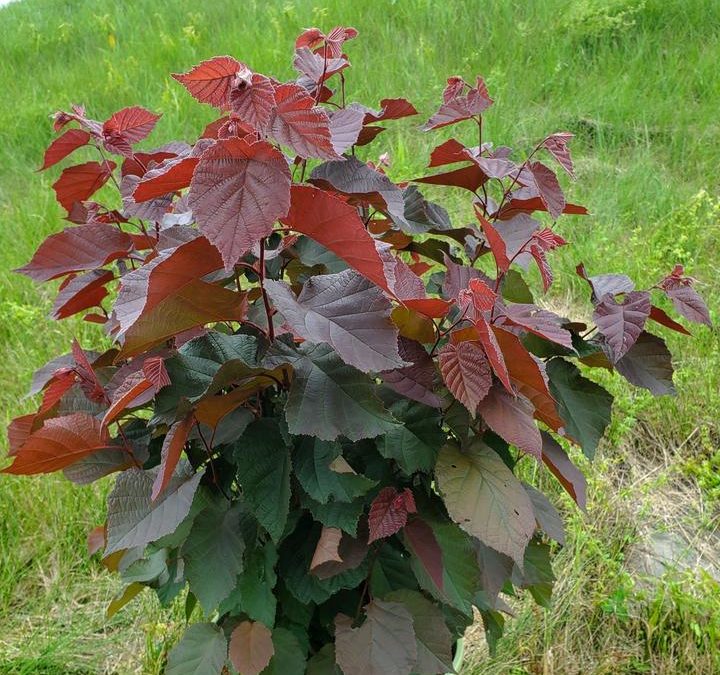
Common Name: American Hazelnut
Bloom Time: Early spring catkins (March–April) with edible nuts in late summer to fall
USDA Zones: 4–9 (hardy in Southeastern Wisconsin)
Mature Size: 10–16 ft. tall × 8–13 ft. wide
Habit: Multi-stemmed, rounded shrub or small tree
Foliage: Broad, rounded green leaves with yellow to orange-red fall color
Introduction
A native shrub that offers beauty, wildlife value, and edible rewards, the American Hazelnut (Corylus americana) is a versatile plant for Wisconsin landscapes. With its graceful vase shape, ornamental catkins in spring, and nut clusters ripening by late summer, it brings interest to the garden nearly year-round. For homeowners who want to combine ornamental landscaping with edible gardening, this native shrub is a natural fit.
Though the Purpleleaf Select Hazelnut (Corylus americana ‘Purpleleaf Select’) is currently out of stock at Heritage Hill Nursery, it’s worth keeping on your radar for its ornamental purple foliage paired with all the benefits of our native species.
👉 View Corylus americana ‘Purpleleaf Select’
Origins & Description
The American Hazelnut is native across much of the eastern and central United States, thriving in woodland edges, thickets, and prairies. It is highly adaptable, making it an excellent choice for naturalized areas, edible landscapes, or as a hedgerow plant.
In spring, it produces yellow-brown catkins (male flowers) that dangle from bare stems before the leaves emerge. By late summer, rounded clusters of edible nuts form, each enclosed in leafy husks. These nuts are smaller than those of European hazelnuts but equally delicious, with a sweet, rich flavor prized by wildlife and people alike.
The foliage is broad, slightly heart-shaped, and turns bright yellow to orange-red in fall, adding ornamental appeal to the landscape.
Ideal Growing Conditions (Southeast Wisconsin Focus)
-
Light: Full sun to part shade. Plants in full sun produce more nuts, while part shade works for ornamental plantings.
-
Soil: Tolerates a wide range, from sandy loam to heavier clay. Prefers well-drained, fertile soils.
-
Moisture: Average moisture needs. Established plants tolerate short dry spells.
-
pH: Slightly acidic to neutral soils (6.0–7.0) are ideal.
-
Hardiness: Extremely hardy in Wisconsin winters, reliably surviving subzero temperatures.
Planting & Establishment
When to Plant:
How to Plant:
-
Dig a hole twice the width of the root ball.
-
Place the plant at the same depth it was growing in the container.
-
Backfill with native soil and water deeply.
-
Apply a 2–3 inch mulch layer to conserve moisture and suppress weeds.
Pollination Note: Hazelnuts are wind-pollinated and do best when two or more plants are grown together for good nut set.
Care & Maintenance
-
Watering: Provide regular water during the first two years. Once established, hazelnuts are drought-tolerant.
-
Pruning: Minimal pruning needed. Remove crossing branches or suckers in late winter to maintain shape.
-
Fertilization: Apply compost or a balanced fertilizer in early spring if soil is poor.
-
Pests & Disease: Generally low-maintenance. Occasional leaf spots or blight may appear, but rarely serious in home landscapes. Deer and rabbits may browse young shoots, so protection may be needed during establishment.
Propagation
-
Division: Plants can spread by suckering, and these shoots can be transplanted.
-
Seed: Can be grown from nuts, though seed-grown plants may take longer to produce.
-
Cultivars: Named selections like ‘Purpleleaf Select’ offer ornamental foliage and consistent nut quality.
Landscape Uses & Companions
-
Edible Landscapes: Hazelnuts are perfect for permaculture or food forests.
-
Hedgerows: Their dense growth provides natural screening and wildlife shelter.
-
Pollinator & Wildlife Gardens: Early catkins provide pollen for native bees; nuts feed birds, squirrels, and other wildlife.
-
Companions: Combine with serviceberry, viburnum, or native dogwoods for layered wildlife-friendly plantings.
Seasonal Calendar (Wisconsin)
-
March–April: Catkins bloom, providing early-season pollen.
-
May–August: Foliage fills out; nut clusters begin forming.
-
September–October: Nuts ripen; leaves turn bright yellow to orange-red.
-
Winter: Shrubs provide structural interest and wildlife shelter.
Troubleshooting
-
Sparse Nut Set: Often due to lack of cross-pollination. Plant at least two for reliable yields.
-
Poor Growth: Usually from overly wet soils. Ensure proper drainage.
-
Animal Pressure: Protect young plants from deer and rabbits until established.
Ecological & Garden Value
-
Wildlife Habitat: Provides food (nuts) and shelter for birds and mammals.
-
Pollinator Support: Catkins are a valuable early-season pollen source.
-
Native Plant Advantage: Thrives in Wisconsin’s climate with little intervention.
-
Edible Yield: A beautiful shrub that also provides a sweet, nutritious nut crop.
Ready to Plant?
If you’re looking for a native shrub that blends ornamental beauty with practical harvests, the American Hazelnut is an outstanding choice. Perfect for edible landscapes, hedgerows, and wildlife gardens, it’s both functional and attractive.
👉 View Corylus americana ‘Purpleleaf Select’
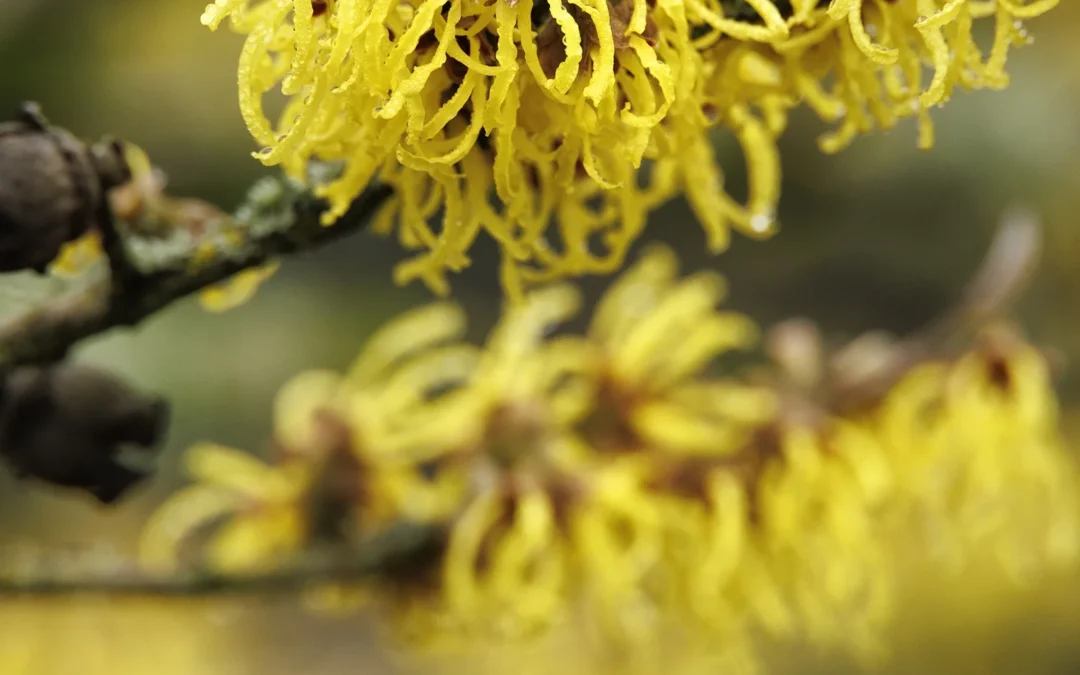
Common Name: Arnold Promise Witch Hazel
Bloom Time: Late winter to early spring (February–March)
USDA Zones: 5–8 (hardy in Southeastern Wisconsin)
Mature Size: 12–15 ft. tall × 10–12 ft. wide
Habit: Vase-shaped, multi-stemmed shrub
Flower Color: Bright yellow, fragrant, ribbon-like petals
Introduction
When most of the garden is still asleep under a blanket of snow, Arnold Promise Witch Hazel wakes up the landscape with a burst of sunshine-yellow blooms. One of the earliest flowering shrubs for Southeastern Wisconsin, it brings color, fragrance, and hope to late winter when gardeners need it most. Its ribbon-like petals unfurl on bare branches, often when snow is still on the ground, and perfume the air with a sweet, spicy scent.
This cultivar is part of the hybrid group Hamamelis × intermedia and is celebrated for its showy late-winter flowers, strong cold hardiness, and reliable garden performance.
Heritage Hill Nursery carries this standout selection:
👉 Shop Arnold Promise Witch Hazel
Origins & Description
Witch hazels are native to both North America and Asia, with hybrid forms (Hamamelis × intermedia) bred to combine the best traits of their parent species. ‘Arnold Promise’ was introduced by the Arnold Arboretum in Massachusetts and has since become a classic late-winter bloomer for northern gardens.
This deciduous shrub grows in a graceful, vase-shaped form, eventually reaching 12–15 feet tall and 10–12 feet wide. The standout feature is its fragrant, spidery yellow blooms, appearing in late February or March. Flowers often overlap with snowmelt, making them a rare source of early-season color and nectar.
In autumn, foliage turns brilliant shades of golden yellow, extending its ornamental value. The bark and branch structure also provide winter interest, making Arnold Promise a true four-season shrub.
Ideal Growing Conditions (Southeast Wisconsin Focus)
-
Light: Full sun to part shade. Best flowering occurs with at least 6 hours of direct sun.
-
Soil: Prefers loamy, well-drained soils, rich in organic matter. Avoid heavy, poorly drained clay.
-
Moisture: Evenly moist soil is ideal. While established plants tolerate some drought, consistent moisture supports stronger blooms.
-
pH: Slightly acidic to neutral soils (5.5–7.0).
-
Hardiness: Zone 5 hardy; thrives in Wisconsin winters with no extra protection once established.
Planting & Establishment
When to Plant:
How to Plant:
-
Dig a hole twice as wide and as deep as the root ball.
-
Place the shrub so the crown is level with the surrounding soil.
-
Backfill with soil enriched with compost.
-
Water thoroughly and mulch with 2–3 inches of organic material, keeping mulch a few inches away from stems.
Spacing: Plant 10–12 feet apart if using multiple shrubs to allow room for natural spread.
Care & Maintenance
-
Watering: Regular watering the first 2 years ensures a strong root system. After establishment, only water during prolonged dry spells.
-
Feeding: In spring, apply a balanced, slow-release fertilizer or compost to promote flowering and foliage health.
-
Pruning: Minimal. Prune lightly after flowering in spring to shape or remove deadwood. Avoid heavy pruning, as it can reduce next year’s bloom.
-
Pests & Disease: Generally pest- and disease-free. Deer usually leave witch hazels alone.
-
Winter Care: No special protection needed. Flowers withstand cold snaps; petals may curl in freezing temps but unfurl again with warmer weather.
Landscape Uses & Companions
-
Specimen Plant: Place in a prominent spot where its late-winter blooms can be enjoyed. Near entryways or patios is ideal.
-
Mixed Borders: Combine with other early bloomers like hellebores or snowdrops for layered late-winter interest.
-
Woodland Edge: Thrives at the edge of a woodland garden where it can catch sunlight.
-
Four-Season Interest: Offers winter flowers, spring freshness, summer greenery, and brilliant fall foliage.
Companions: Early-blooming bulbs (crocus, snowdrops, daffodils), shade-tolerant perennials (hosta, astilbe), and other shrubs with staggered bloom times (serviceberry, viburnum).
Seasonal Calendar (Wisconsin)
-
February–March: Fragrant yellow blooms open on bare branches.
-
April–May: Leaf-out; fertilize lightly.
-
Summer: Dense green foliage provides shade and structure.
-
September–October: Leaves turn golden yellow.
-
Winter: Strong branching adds interest against snow; buds prepare for next season.
Troubleshooting
-
Poor Bloom: Usually due to too much shade or water stress in summer. Relocate to sunnier, evenly moist soil.
-
Leggy Growth: Caused by excessive shade. Light pruning after bloom helps maintain form.
-
Slow Growth: Witch hazels are naturally slow to establish; patience pays off with decades of beauty.
Ecological & Garden Value
-
Pollinators: Provides nectar for early pollinators, including bees, when few other plants are blooming.
-
Wildlife Resistance: Rarely browsed by deer or rabbits.
-
Four-Season Beauty: Flowers, foliage, and structure keep the garden attractive year-round.
-
Native Heritage: Though a hybrid, it shares traits with North American witch hazels, which were historically used for medicinal purposes.
Ready to Plant?
If you want to bring a burst of life and fragrance to the late-winter garden, the Arnold Promise Witch Hazel is the shrub for you. With its dependable bloom time, glowing fall color, and easy-care nature, it’s an excellent choice for Wisconsin landscapes.
👉 Shop Arnold Promise Witch Hazel





